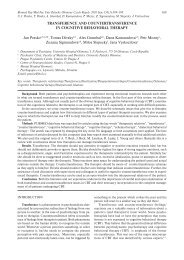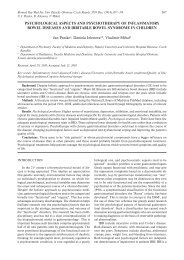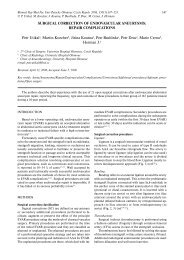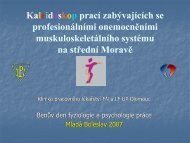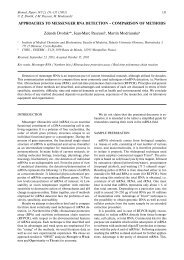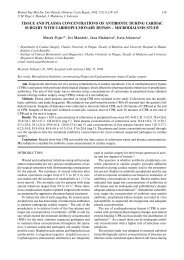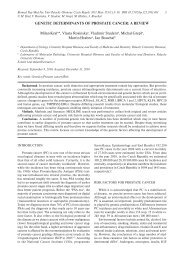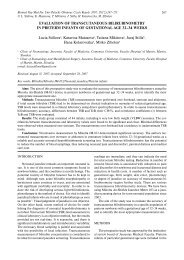A MICROBIOLOGICAL APPROACH TO ACNE VULGARIS Yvona ...
A MICROBIOLOGICAL APPROACH TO ACNE VULGARIS Yvona ...
A MICROBIOLOGICAL APPROACH TO ACNE VULGARIS Yvona ...
You also want an ePaper? Increase the reach of your titles
YUMPU automatically turns print PDFs into web optimized ePapers that Google loves.
Biomed. Papers 146(2), 29–32 (2002)© Y. Lovečková, I. Havlíková29A <strong>MICROBIOLOGICAL</strong> <strong>APPROACH</strong> <strong>TO</strong> <strong>ACNE</strong> <strong>VULGARIS</strong><strong>Yvona</strong> Lovečková* a , Ilona Havlíková baInstitute of Microbiology, Faculty of Medicine, Palacký University, and Teaching Hospital in Olomouc, Hněvotínská 3,775 15 OlomoucbDepartment of Dermatology, Faculty of Medicine, Palacký University, and Teaching Hospital in OlomoucReceived: September 17, 2002Key words: Acne vulgaris / Triglycerides / Propionibacterium / Hormones / Antibiotics / Isotretinoine / VaccinationThe present article gives a concise survey of contemporary opinions on acne vulgaris, its etiopathogenesis,clinical forms and laboratory diagnostics. In particular, the value of microbiological diagnostics and possibilities oflocal as well as general therapy are discussed. Moreover, our experience is described with vaccinotherapy tomanage serious clinical forms and cases when current herapy fails.INTRODUCTIONAcne vulgaris is a chronic inflammatory disease ofthe pilosebaceous unit (sebaceous glands and hair follicles)frequently occurring in a large part of mainlyyounger population groups. In principle, it is a disorderof adolescence, but it persists until the middle age ina minority of individuals. Acne vulgaris occurs in severalclinical forms. Severe forms of acne are often therapyresistantwhich has mostly a very negative impact on thepatients.The disorder of the pilosebaceous unit is of a multifactorialcharacter. The proportion of individual pathogenicfactors including genetic ones can differ witha resulting variability of clinical forms of acne. In manycases, the influence of various etiopathogenic factors iscombined 13, 11, 15, 24, 45, 50 .ETIOPATHOGENESISIn patients, an increased production of sebum ismanifested, and its quantity and quality varies dependingon the hormone regulation. Besides direct hormonaleffects, there is also involved a genetically conditionedsensitivity of sebaceous glands to the influence ofandrogens which is higher in persons suffering fromacne. In general, androgens stimulate the formation ofsebum, while estrogens reveal a suppressive effect on it.The activity of sebaceous glands is thus dependent onthe ratio of estrogens and androgens 24, 45 . The increasedlevel of androgens in adolescence is known to bea starting point for the development of juvenile acne.The amount of triglycerides in sebum increases up to50% and together with their quantity, population ofpropionibacteria is enlarging, too 48 .In acne, keratinization is also impaired. An increasedproduction of keratinizing cells in follicular canals togetherwith a decrease of their elimination leads to theaccumulation of sebaceous matter. The primary manifestationof acne is formed – a comedo. In the formationof comedos, essential fatty acids are also involved. Decreasedlocal concentration of linoleic acid is joinedwith follicular hyperkeratosis 10, 48 .In the pathogenesis of acne, the natural skin microfloraplays a marked role too, namely the gram-positiveanaerobic rod Propionibacterium acnes, in a lesser extentalso Propionibacterium granulosum, event. otherspecies. Propionibacteria present a number of enzymaticactivities. Their lipases cleave sebaceous diacylglycerolsand triacylglycerols to glycerol and free fattyacids that induce proliferative hyperkeratosis in the follicularcanal, thus producing a comedogenic effect. Itsirritating effect (pH decrease) lead to the impairmentup to the rupture of comedo covering 19 . Proteases ofpropionibacteria enable the permeation of follicle contentthrough its wall and hyaluronidases support itsspreading in the dermis. The clinical consequences ofthese processes are papules, pustules, induration andabscesses 19 .Propionibacteria influence both cellular and humoralcomponents of the immune system 24, 36 . They are able topersist in macrophages and increase chemotaxis of polymorphonuclearleukocytes. They are also cytotoxicallyactive, are able to activate the complement in an alternativeway and bring about the hypersensitivity of earlyor late type 45, 47 . Other products of propionibacteria arephosphatases, neuraminidases, deoxyribonucleases andnamely substances close to prostaglandins with markedimportance in the formation of inflammatory manifestationsof acne 5, 49, 51 .
30Y. Lovečková, I. HavlíkováOther bacteria of cutaneous microflora [namely Staphylococcusepidermidis] can also produce the abovegiven enzymes and get involved in the acne etiology 5, 16, 19 .Immune mechanisms also contribute to the formationof reactive inflammation. An intradermal test withthe suspension of killed propionibacteria in patientswith the severe form of acne shows after 48 hours a significantlygreater inflammatory reaction than in healthypersons. In these patients, an increase of specific antibodiesis also registered 4, 17, 40, 41, 42 .DIAGNOSTICS OF <strong>ACNE</strong>Diagnostics of acne is based on the clinical pictureand laboratory evidence of Propionibacterium and Staphylococcusbacteria whose quantity in the examinedpus is usually increased. The technique of sampling isvery important – it is necessary to get a sample of pusformed in the bottom part of the inflamed follicle. Theobtained material is inoculated on appropriate cultivationsoils for anaerobic bacteria (Wilkins-Chalgren agar,Schaedler agar, Clostridial agar and others), usuallyenriched with 5% of ram blood. On properly withdrawnsamples, non-sporulating rods of propionibacteria growafter 48-hour incubation at 37 °C, forming huge whiteor yellowish colonies, often surrounded with a zone ofcomplete hemolysis. Microscopic image is described asgram-positive slightly club-like rods. The species identificationutilizes biochemical tests (Anaerotest 23Lachema, ApiA Bio-Mérieux etc.) and the prevailingfinding is Propionibacteium acnes. This strain is typicalby the production of catalase and indol 2, 15, 29 .For the determination of staphylococci, the materialis inoculated on agar soil (e.g. Columbia Blood AgarBase also enriched with 5% of ram blood). Staphylococcigrow after 24-hour incubation at 37 °C in aerobicatmosphere as typical white or yellow pigmented colonies,often with a zone of complete hemolysis. They areidentified with the help of biochemical test kits (ApiStaph Bio-Mérieux, Staphy 16 Lachema and others).Latex identification tests are used for fast identificationof Staphylococcus aureus strain.Differential diagnostics is important for the differentiationof acne caused by external factors and acneiformeruptions. External causes of acne can be the influenceof various chemical substances manifesting comedoniceffects (natural oil derivatives, detergents, cosmetic products).The causes may be physical ones too – acnemechanica (efflorescence in sites of intensive mechanicalcontact) or Mallorca acne (reaction to an increasedtemperature and humidity of environment). An etiologicagent in the formation of acneiform efflorescencecan be a mite (Demodex folliculorum).Acneiform eruptions (acne medicamentosa) are provokedby various generally applied medicaments. Theformation is mostly abrupt and it might appear afteradministration of steroids, anti-epileptic agents, sedatives,vitamins B6 and B12, preparations containing bromineand iodine, event. other agents 11, 12, 15, 24, 45 .THERAPYAcne vulgaris often represents a therapeutic problem.In mild forms of the disease, the local therapy isadvantageous, mostly reaching a very good therapeuticeffect. Azelainic acid is frequently used, with antibacterialinfluence without bacterial resistance. Therefore,its administration is not time-limited 19 . Among otheragents, tretinoin is to be mentioned (a vitamin A derivative),as well as benzoylperoxide, influencing namelyinflammatory manifestations and its advantage is a fasteronset of influence in comparison with tretinoin. Forpatients with sensitive complexion, local drug formscontaining antibiotics can be effective; usually erythromycin(1–4 %) or clindamycin (1 %). A possible formationof bacterial resistance is limiting their use, so themaximum interval of treatment is 2–3 months. The resistanceis usually of temporary character and the therapycan be repeated later. Another alternative is clotrimazol.It is used even as a component of a make-up (Acnecolor,11, 14, 15, 24, 31,Acnecolor light) with good concealing effect34, 25, 45, 49.Severe forms of acne (large acne papulopustulosa,acne nodularis, acne conglobata, acne fulminans, acnetetrada) need the application of systemic treatment.Complex therapy of acne involves the application oforal antibiotics, hormones, isotretinoin and bacterialvaccines.Oral therapy with bacteriostatic antibiotics can reducethe microbial colonization of follicles by staphylococciand above all by propionibacteria. Tetracyclinedrugs exert a favorable influence on acne even in lowdoses that do not alter quantitative condition of thecutaneous microflora, but they can inhibit the synthesisof bacterial enzymes, including lipases. Other antibioticagents are also being applied (macrolides, lincosamides),in dependence on the limits for tetracycline indicationand according to the verified therapy used by variouscenters. Sulfonamides are utilized in the acne therapytoo, but the authors’ opinions on their use in this indicationare different 7, 8, 11, 15, 24, 26, 31, 32, 45, 49 .Hormones are also effective in the treatment ofacne. Their administration is connected with the widespreaduse of oral birth-control pills. In women, antiandrogencyproteronacetate in combination with ethinylestradiol(Diane-35) can be used.Recently, a derivative of vitamin A isotretinoin hasbeen introduced into the therapy of acne. It decreasesmarkedly the formation of sebum and reduces the populationof propionibacteria. Its administration is limitedfor the most severe forms where the preceding systemictherapy was not sufficiently effective 1, 3, 11, 15, 24, 30 .Another approach to the therapy of acne is the applicationof auto- or stockvaccines containing inactivatedstrains of propionibacteria and/or staphylococci 6, 9, 33 .
A microbiological approach to acne vulgaris31Their effect is based on the non-specific modulation ofthe immune system of patients 9, 12, 20–24, 33, 34 . The vaccinotherapyis usually applied together with external treatmentand follows the systemic antibiotic therapy whenthe pronounced inflammatory manifestations are eliminated43, 44 . Contrarily to wide-specter antibiotics thatcan cause the recession of the disease without any effecton possible recurrent attacks after the end of their application,the use of oral vaccines reveals a long-termfavorable effect 23, 24 .The Teaching Hospital in Olomouc has a long historyof vaccinotherapy use. Whole cell stockvaccines ofstandard composition are preferred (Propionibacteriumacnes, Staphylococcus aureus, Staphylococcus epidermidisin the ratio 1:1:1). They are prepared using the cellophanetechnique with following inactivation of obtainedgerms and their lyophilization. They can be applied assubcutaneous injection or in oral forms of drops, capsulesor tablets. Basing on the experience, it can bestated that the vaccinotherapy shows a very good effectwithout unwanted side effects in most patients. Thetherapy failed at less than 2 % of patients, no worseningof the state was registered. The differences in the effectivenessof individual drug forms (injections, tablets,capsules and drops) was not described 23, 37–39 . It wasconfirmed that the proper onset of vaccination in mildforms of acne prevents the development of severe caseswith permanent consequences. Vaccines can be appliedin all cases of acne papulopustulosa, conglobata, indurationor abscess forms. Priors to the vaccine therapy,biochemical, hematological and immunological examinationsare to be performed. When a clinical improvementis reached as the result of antibiotic therapy, it isrecommendable to continue with vaccinotherapy, eventuallywith another immunotherapy, according to theresults of immunological tests 15, 45, 46, 49 .CONCLUSIONIt can be concluded that acne is a typical disease ofyoung age and it often represents a major psychic traumafor the patients. The results of non-treated or insufficientlytreated disease are frequent scars, also influencingnegatively the psychic condition of patients. Regardingto the constantly improving diagnostic methodsand various therapeutic possibilities, it is feasible toreach a favorable therapeutic effect in most cases. Thedisease can thus be influenced at its beginning, estheticdamage can be prevented and the economic costs resultingfrom chronic character of the process can bedecreased.ACKNOWLEDGEMENTSThe study was supported by the Research Project MSM151100002.REFERENCES1. Auffret N (2000) Acne today. What’s new? Presse Medicale.29(19):1091–7.2. Bednář M, Fraňková V, Schindler J, Vávra J (1996) Lékařskámikrobiologie. Marvil, 292–293.3. Bershad SV (2001) The modern age of acne therapy: a review ofcurrent treatment options. Mount Sinai Journal of Medicine.68 (4–5):279–86.4. Burkhart CG, Cantrill J, Butcher CL, Lehmann PF (1999) Propionibacteriumacnes: interaction with complement and developmentof an enzyme-linked immunoassay for detection of antibody.Int J of Derm 38 (3): 200–3.5. Burkhart CG, Burkhart CN, Lehmann PF (1999) Acne: a reviewof immunologic and microbiologic factors. Postgraduate MedicalJ. 75 (884): 328–31.6. Březina Z (1986) Několik poznámek k imunomodulátorům STAVAa STAFAL. Prakt Lék (Praha) 66: 430–431.7. Coates P, Vyakrnam S, Eady EA, et al. (2002) Prevalence ofantibiotic-resistant propionibacteria on the skin of acne patients:10-year surveillance data and snapshot distribution study. Br JDermatol 146 (5): 840–8.8. Carrasco DA, Vander Straten M, Tyring SK (2002) A review ofantibiotics in dermatology. J Cutan Med Surg 6 (2): 128–50.9. Černá I, Baová D, Horák V, et al. (1977) Preparation of stafyloccocalvaccine and its application to chronic infections. ActaUniv Palacki Olomuc, Fac Med 83: 349–361.10. Federman DG, Kirsner RS (2000) Acne vulgaris: pathogenesisand therapeutic approach. American Journal of Managed Care 6(1): 78–87.11. Fitzpatrick TB, et al. (1997) Color atlas and synopsis of clinicaldermatology. McGraw-Hill comp. 2–14.12. Fleming A (1909) On the etiology of acne vulgaris and its treatmentby vaccine. Lancet 176: 1035–1038.13. Goulden V, McGeown Ch, Cunliffe WJ (1999) The familiar riskof adult acne: a comparison between first-degree relatives ofaffected and unaffected individuals. Br J Dermatol 141 (2):297–300.14. Chan JJ, Rohr JB (2000) Acne vulgaris: yesterday, today andtomorrrow. Australasian Journal of Dermatology 41: 69–72.15. Chu T, Munn S, Basarab T (1996) Current issues in dermatology.Acne. London: Maxim Medical, 1–57.16. Jappe U (2000) Superantigens and their association with dermatologicalinflammatory diseases: facts and hypotheses. Acta Dermato-Venerologica,80 (5): 321–8.17. Jappe U, Inhgam E, Henwood J, Holland KT (2002) Propionibacteriumacnes and inflammation in acne; P. Acnes has T-cell mitogenicactivity. Br J Dermatol, 146 (2): 202–9.18. Kasprowicz A, Klosinski A, Heczko PB (1986) Leczenie zmiantradzikowych przy zastowaniu antigénov Propionibacterium wformie szcepionki doustnej. Med Došw Microbiol; 38: 73–78.19. Korandová H, Viktorinová M (1994) Zevní léčba akné kyselinouazelainovou. Čs Derm; 69: 189–193.20. Koukalová D, Koousek R, Hájek V, Kolář M (1992) Experimentalnonspecific immunostimulation by the Propionibacterium acnesvaccine. Acta Univ Palacki Olomuc, Fac Med; 133: 19–23.21. Koukalová D, Viktorinová M (1992) Kožní testy s mikrobiálnímiantigeny. Chronické stafylokokové pyodermie. Čs Derm; 67:133–139.22. Koukalová D, Viktorinová M (1992) Kožní testy s mikrobiálnímiantigeny. Mikrobiální ekzém. Čs Derm; 67: 269–274.23. Koukalová D, Viktorinová M (1995) Perorální vakcinoterapiev dermatologii. Epidemiol Mikrobiol Imunol; 44: 1: 36–43.24. Kučerová R, Buček M, Viktorinová M, Sheetyová R (1998) Acnevulgaris jako terapeutický problém – současné možnosti léčbyv zrcadle našich zkušeností. Olomoucké dermatologické přednáškovéodpoledne, Olomouc 1998.25. Kurokawa I, Nishijima S, Kawabata S (1999) Antimicrobial susceptibilityof Propionibacterium acnes isolated from acne vulgaris.European Journal of Dermatology; 9 (1): 25–8.
32Y. Lovečková, I. Havlíková26. Leyden JJ (2001) Current issues in antimicrobial therapy for thetreatment of acne. J Eur Acad Dermatol Venerol; 15 Suppl.27. Leyden JJ (1995) New understanding of the pathogenesis of acne.J Amer Acad Derm; 32: 15–25.28. Maršálek E, Malota H, Černá I (1983) Závěry ze symposiao vakcinoterapii. Imunol Zpravodaj; 14: 44–47.29. Nishijima S, Kurokawa I, Katoh N, Watanabe K (2000) Thebacteriology of acne vulgaris and antomicrobial susceptibility ofPropionibacterium acnes and Staphyloccus epidermidis isolatedfrom acne lesions. Journal of Dermatology; 27(5): 318–23.30. O’Donoghue MN (1999) Update on acne therapy. DermatologyNursing; 11 (3): 205–8.31. Plewig G (1987) Aknetherapie: Gesichertes und Zukünftiges.Med Welt; 38: 278–283.32. Ross JI, Snelling AM, Eady EA, et al. (2001) Phenotypic andgenotypic characterization of antibiotic-resistant Propionibacteriumacnes isolated from acne patients attending dermatologyclinics in Europe, the U.S.A., Japan and Australia. Br J Dermatol.;144 (2): 225–7.33. Sedláček K (1937) Immunotherapie. Praha. VN – J. Tožička, 590.34. Sevin W, Dietz H (1960) Das Syndrom Akne. Externe und interneTherapie. Derm Wschr; 141: 52–54.35. Slačálková V, Janoška A, Křepelka V (1965) Stafylokokový anatoxinv léčbě stafylodermií. Čs Derm; 40:166–172.36. Stickl H, Hüllstrung HW, Gillesberger W (1974) Über eineimmunobiologische Behandlung der Akne vulgaris. Münch medWschr; 49: 2141–2146.37. Viktorinová M, Koukalová D (1990) Naše zkušenosti s vakcinačníléčbou akné. I. Injekční vakcíny – dlouhodobé sledování. Čs Derm;65: 158–164.38. Viktorinová M, Koukalová D (1990) Naše zkušenosti s vakcinačníléčbou akné. II. Perorální kapkové vakcíny. Čs Derm; 65: 322–327.39. Viktorinová M, Koukalová D (1994) Naše zkušenosti s vakcinačníléčbou akné. III. Perorální tabletové vakcíny. Čs Derm; 4: 175–178.40. Viktorinová M, Koukalová D (1992) Kožní testy s mikrobiálnímiantigeny. Akné. Čs Derm; 67: 140–149.41. Viktorinová M, Koukalová D (1993) Kožní testy s mikrobiálnímiantigeny. Atopický ekzém. Čs Derm; 68: 3–7.42. Viktorinová M, Koukalová D (1990) Vliv mikroorganismů prostředína změnu kožní reaktivity. Závěrečná zpráva výzkumnéhoúkolu 16-01-04. Olomouc 1–106.43. Viktorinová M, Koukalová D (1986) Mikrobiální ekzém. 4. Léčbainjekční stafylokokovou vakcínou. Čs Derm; 61: 301–307.44. Viktorinová M, Koukalová D (1986) Mikrobiální ekzém. 5. Léčbaperorální stafylokokovou vakcínou. Čs Derm; 61: 308–313.45. Vohradníková O (1998) Acne vulgaris – klinické varianty, diferenciálnídiagnostika a možnosti terapie. Čs Derm; Tematickápříloha: 1–8.46. Vohradníková O, Bednář M, Kratochvílová M, Záruba F (1991)Perorální vakcíny v léčbě akné. Čs Derm; 66: 95–102.47. Voldánová A (1964) Stafylokokový anatoxin u chronických kožníchnemocí stafylokokové etiologie. Čs Derm; 39: 315–319.48. Webster GF (1999) Acne vulgaris – State of the science. ArchDermatol; 135: 1101–1102.49. Výmola F, Buda J, Lochmann O, et al. (1971) Acne. Imunoterapiea volba antibiotik. Čs Derm; 46: 28.50. Yeon HB, Lindor NM, Seidman JG, Seidman CE (2000) Pyogenicarthritis, pyoderma gangrenosum, and acne syndrome mapsto chromosome 15q. American Journal of Human Genetics; 66(4): 1443–8.51. Zimakoff J, Rosdahl VT, Petersen W, Scheibel J (1988) Reccurentstaphylococcal furunculosis in families. Scand J Infect Dis; 20:403–405.




